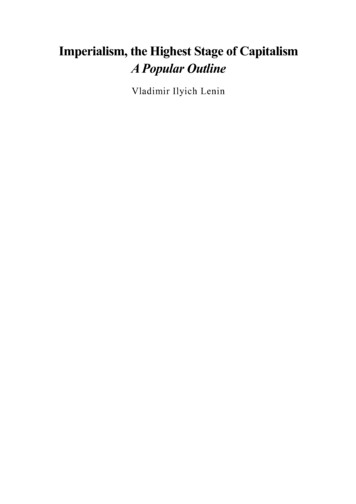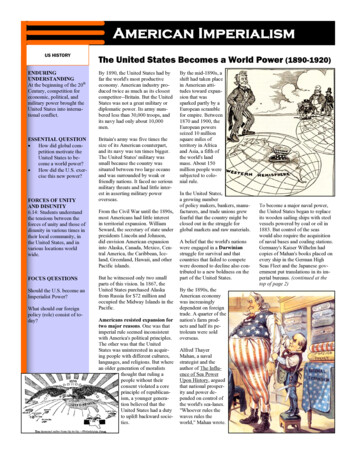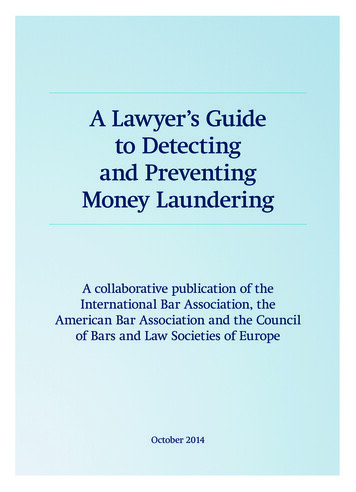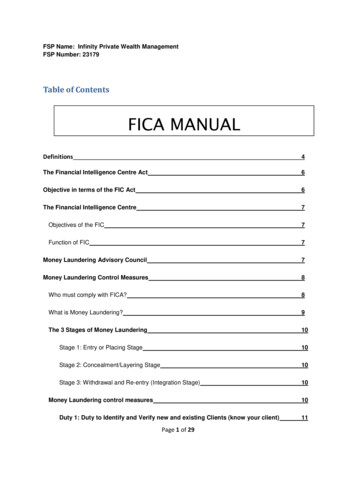
Transcription
Imperialism, the Highest Stage of CapitalismA Popular OutlineVladimir Ilyich Lenin
Written: January-June, 1916Published: First published in mid-1917 in pamphlet form, Petrograd. Publishedaccording to the manuscript and verified with the text of the pamphlet.Source: Lenin’s Selected Works, Progress Publishers, 1963, Moscow, Volume 1, pp.667766.Transcription\Markup: Tim Delaney & Kevin Goins (2008)Public Domain: Lenin Internet Archive 2005. You may freely copy, distribute, displayand perform this work; as well as make derivative and commercial works. Please credit“Marxists Internet Archive” as your source.
Table of ContentsPreface . 4Preface to the French and German Editions . 5I. Concentration of Production and Monopolies. 10II. Banks and Their New Role. 20III. Finance Capital and the Financial Oligarchy . 33IV. Export of Capital . 45V. Division of the World Among Capitalist Associations . 50VI. Division of the World Among the Great Powers . 57VII. Imperialism as a Special Stage of Capitalism . 66VIII. Parasitism and Decay of Capitalism . 75IX. Critique of Imperialism . 82X. The Place of Imperialism in History . 92
PrefaceThe pamphlet here presented to the reader was written in the spring of 1916, in Zurich.In the conditions in which I was obliged to work there I naturally suffered somewhatfrom a shortage of French and English literature and from a serious dearth of Russianliterature. However, I made use of the principal English work on imperialism, the bookby J. A. Hobson, with all the care that, in my opinion, that work deserves.This pamphlet was written with an eye to the tsarist censorship. Hence, I was not onlyforced to confine myself strictly to an exclusively theoretical, specifically economicanalysis of facts, but to formulate the few necessary observations on politics withextreme caution, by hints, in an allegorical language—in that accursed Aesopianlanguage—to which tsarism compelled all revolutionaries to have recourse wheneverthey took up the pen to write a “legal” work.It is painful, in these days of liberty, to re-read the passages of the pamphlet which havebeen distorted, cramped, compressed in an iron vice on account of the censor. That theperiod of imperialism is the eve of the socialist revolution; that social-chauvinism(socialism in words, chauvinism in deeds) is the utter betrayal of socialism, completedesertion to the side of the bourgeoisie; that this split in the working-class movement isbound up with the objective conditions of imperialism, etc.—on these matters I had tospeak in a “slavish” tongue, and I must refer the reader who is interested in the subjectto the articles I wrote abroad in 1914-17, a new edition of which is soon to appear. Inorder to show the reader, in a guise acceptable to the censors, how shamelesslyuntruthful the capitalists and the social-chauvinists who have deserted to their side (andwhom Kautsky opposes so inconsistently) are on the question of annexations; in orderto show how shamelessly they screen the annexations of their capitalists, I was forced toquote as an example—Japan! The careful reader will easily substitute Russia for Japan,and Finland, Poland, Courland, the Ukraine, Khiva, Bokhara, Estonia or other regionspeopled by non-Great Russians, for Korea.I trust that this pamphlet will help the reader to understand the fundamental economicquestion, that of the economic essence of imperialism, for unless this is studied, it willbe impossible to understand and appraise modern war and modern politics.AuthorPetrograd, April 26, 1917
Preface to the French and German EditionsIAs was indicated in the preface to the Russian edition, this pamphlet was written in1916, with an eye to the tsarist censorship. I am unable to revise the whole text at thepresent time, nor, perhaps, would this be advisable, since the main purpose of the bookwas, and remains, to present, on the basis of the summarised returns of irrefutablebourgeois statistics, and the admissions of bourgeois scholars of all countries, acomposite picture of the world capitalist system in its international relationships at thebeginning of the twentieth century—on the eve of the first world imperialist war.To a certain extent it will even be useful for many Communists in advanced capitalistcountries to convince themselves by the example of this pamphlet, legal from thestandpoint of the tsarist censor, of the possibility, and necessity, of making use of eventhe slight remnants of legality which still remain at the disposal of the Communists, say,in contemporary America or France, after the recent almost wholesale arrests ofCommunists, in order to explain the utter falsity of social-pacifist views and hopes for“world democracy”. The most essential of what should be added to this censoredpamphlet I shall try to present in this preface.IIIt is proved in the pamphlet that the war of 1914-18 was imperialist (that is, anannexationist, predatory, war of plunder) on the part of both sides; it was a war for thedivision of the world, for the partition and repartition of colonies and spheres ofinfluence of finance capital, etc.Proof of what was the true social, or rather, the true class character of the war isnaturally to be found, not in the diplomatic history of the war, but in an analysis of theobjective position of the ruling classes in all the belligerent countries. In order to depictthis objective position one must not take examples or isolated data (in view of theextreme complexity of the phenomena of social life it is always possible to select anynumber of examples or separate data to prove any proposition), but all the data on thebasis of economic life in all the belligerent countries and the whole world.It is precisely irrefutable summarised data of this kind that I quoted in describing thepartition of the world in 1876 and 1914 (in Chapter VI) and the division of the world’srailways in 1890 and 1913 (in Chapter VII). Railways are a summation of the basiccapitalist industries, coal, iron and steel; a summation and the most striking index of thedevelopment of world trade and bourgeois-democratic civilisation. How the railwaysare linked up with large-scale industry, with monopolies, syndicates, cartels, trusts,banks and the financial oligarchy is shown in the preceding chapters of the book. Theuneven distribution of the railways, their uneven development—sums up, as it were,
modern monopolist capitalism on a world-wide scale. And this summary proves thatimperialist wars are absolutely inevitable under such an economic system, as long asprivate property in the means of production exists.The building of railways seems to be a simple, natural, democratic, cultural andcivilising enterprise; that is what it is in the opinion of the bourgeois professors who arepaid to depict capitalist slavery in bright colours, and in the opinion of petty-bourgeoisphilistines. But as a matter of fact the capitalist threads, which in thousands of differentintercrossings bind these enterprises with private property in the means of production ingeneral, have converted this railway construction into an instrument for oppressing athousand million people (in the colonies and semicolonies), that is, more than half thepopulation of the globe that inhabits the dependent countries, as well as the wage-slavesof capital in the “civilised” countries.Private property based on the labour of the small proprietor, free competition,democracy, all the catchwords with which the capitalists and their press deceive theworkers and the peasants are things of the distant past. Capitalism has grown into aworld system of colonial oppression and of the financial strangulation of theoverwhelming majority of the population of the world by a handful of “advanced”countries. And this “booty” is shared between two or three powerful world plunderersarmed to the teeth (America, Great Britain, Japan), who are drawing the whole worldinto their war over the division of their booty.IIIThe Treaty of Brest-Litovsk dictated by monarchist Germany, and the subsequent muchmore brutal and despicable Treaty of Versailles dictated by the “democratic” republicsof America and France and also by “free” Britain, have rendered a most useful serviceto humanity by exposing both imperialism’s hired coolies of the pen and pettybourgeois reactionaries who, although they call themselves pacifists and socialists, sangpraises to “Wilsonism”, and insisted that peace and reforms were possible underimperialism.The tens of millions of dead and maimed left by the war—a war to decide whether theBritish or German group of financial plunderers is to receive the most booty—and thosetwo “peace treaties”, are with unprecedented rapidity opening the eyes of the millionsand tens of millions of people who are downtrodden, oppressed, deceived and duped bythe bourgeoisie. Thus, out of the universal ruin caused by the war a world-widerevolutionary crisis is arising which, however prolonged and arduous its stages may be,cannot end otherwise than in a proletarian revolution and in its victory.The Basle Manifesto of the Second International, which in 1912 gave an appraisal of thevery war that broke out in 1914 and not of war in general (there are different kinds ofwars, including revolutionary wars)—this Manifesto is now a monument exposing to
the full the shameful bankruptcy and treachery of the heroes of the SecondInternational.That is why I reproduce this Manifesto (This Manifesto is not given as an appendix tothis edition—Ed) as a supplement to the present edition, and again and again I urge thereader to note that the heroes of the Second International are as assiduously avoiding thepassages of this Manifesto which speak precisely, clearly and definitely of theconnection between that impending war and the proletarian revolution, as a thief avoidsthe scene of his crime.IVSpecial attention has been devoted in this pamphlet to a criticism of Kautskyism, theinternational ideological trend represented in all countries of the world by the “mostprominent theoreticians”, the leaders of the Second International (Otto Bauer and Co. inAustria, Ramsay MacDonald and others in Britain, Albert Thomas in France, etc., etc.)and a multitude of socialists, reformists, pacifists, bourgeois democrats and parsons.This ideological trend is, on the one hand, a product of the disintegration and decay ofthe Second International, and, on the other hand, the inevitable fruit of the ideology ofthe petty bourgeoisie, whose entire way of life holds them captive to bourgeois anddemocratic prejudices.The views held by Kautsky and his like are a complete renunciation of those samerevolutionary principles of Marxism that writer has championed for decades, especially,by the way, in his struggle against socialist opportunism (of Bernstein, Millerand,Hyndman, Gompers, etc.). It is not a mere accident, therefore, that Kautsky’s followersall over the world have now united in practical politics with the extreme opportunists(through the Second, or Yellow International) and with the bourgeois governments(through bourgeois coalition governments in which socialists take part).The growing world proletarian revolutionary movement in general, and the communistmovement in particular, cannot dispense with an analysis and exposure of thetheoretical errors of Kautskyism. The more so since pacifism and “democracy” ingeneral, which lay no claim to Marxism whatever, but which, like Kautsky and Co., areobscuring the profundity of the contradictions of imperialism and the inevitablerevolutionary crisis to which it gives rise, are still very widespread all over the world.To combat these tendencies is the bounden duty of the party of the proletariat, whichmust win away from the bourgeoisie the small proprietors who are duped by them, andthe millions of working people who enjoy more or less petty-bourgeois conditions oflife.
VA few words must be said about Chapter VIII, “Parasitism and Decay of Capitalism”.As already pointed out in the text, Hilferding, ex-“Marxist”, and now a comrade-inarms of Kautsky and one of the chief exponents of bourgeois, reformist policy in theIndependent Social-Democratic Party of Germany, has taken a step backward on thisquestion compared with the frankly pacifist and reformist Englishman, Hobson. Theinternational split of the entire working-class movement is now quite evident (theSecond and the Third Internationals). The fact that armed struggle and civil war is nowraging between the two trends is also evident—the support given to Kolchak andDenikin in Russia by the Mensheviks and Socialist-Revolutionaries against theBolsheviks; the fight the Scheidemanns and Noskes have conducted in conjunction withthe bourgeoisie against the Spartacists in Germany; the same thing in Finland, Poland,Hungary, etc. What is the economic basis of this world-historical phenomenon?It is precisely the parasitism and decay of capitalism, characteristic of its highesthistorical stage of development, i.e., imperialism. As this pamphlet shows, capitalismhas now singled out a handful (less than one-tenth of the inhabitants of the globe; lessthan one-fifth at a most “generous” and liberal calculation) of exceptionally rich andpowerful states which plunder the whole world simply by “clipping coupons”. Capitalexports yield an income of eight to ten thousand million francs per annum, at pre-warprices and according to pre-war bourgeois statistics. Now, of course, they yield muchmore.Obviously, out of such enormous superprofits (since they are obtained over and abovethe profits which capitalists squeeze out of the workers of their “own” country) it ispossible to bribe the labour leaders and the upper stratum of the labour aristocracy. Andthat is just what the capitalists of the “advanced” countries are doing: they are bribingthem in a thousand different ways, direct and indirect, overt and covert.This stratum of workers-turned-bourgeois, or the labour aristocracy, who are quitephilistine in their mode of life, in the size of their earnings and in their entire outlook, isthe principal prop of the Second International, and in our days, the principal social (notmilitary) prop of the bourgeoisie. For they are the real agents of the bourgeoisie in theworking-class movement, the labour lieutenants of the capitalist class, real vehicles ofreformism and chauvinism. In the civil war between the proletariat and the bourgeoisiethey inevitably, and in no small numbers. take the side of the bourgeoisie, the“Versaillese” against the “Communards”.Unless the economic roots of this phenomenon are understood and its political andsocial significance is appreciated, not a step can be taken toward the solution of thepractical problem of the communist movement and of the impending social revolution.Imperialism is the eve of the social revolution of the proletariat. This has beenconfirmed since 1917 on a world-wide scale.
N. LeninJuly 6, 1920During the last fifteen to twenty years, especially since the Spanish-American War(1898) and the Anglo-Boer War (1899–1902), the economic and also the politicalliterature of the two hemispheres has more and more often adopted the term“imperialism” in order to describe the present era. In 1902, a book by the Englisheconomist J. A. Hobson, Imperialism, was published in London and New York. Thisauthor, whose point of view is that of bourgeois social-reformism and pacifism which,in essence, is identical with the present point of view of the ex-Marxist, Karl Kautsky,gives a very good and comprehensive description of the principal specific economic andpolitical features of imperialism. In 1910, there appeared in Vienna the work of theAustrian Marxist, Rudolf Hilferding, Finance Capital (Russian edition, Moscow, 1912).In spite of the mistake the author makes on the theory of money, and in spite of a certaininclination on his part to reconcile Marxism with opportunism, this work gives a veryvaluable theoretical analysis of “the latest phase of capitalist development”, as thesubtitle runs. Indeed, what has been said of imperialism during the last few years,especially in an enormous number of magazine and newspaper articles, and also in theresolutions, for example, of the Chemnitz and Basle congresses which took place in theautumn of 1912, has scarcely gone beyond the ideas expounded, or more exactly,summed up by the two writers mentioned above.Later on, I shall try to show briefly, and as simply as possible, the connection andrelationships between the principal economic features of imperialism. I shall not be ableto deal with the non-economic aspects of the question, however much they deserve to bedealt with. References to literature and other notes which, perhaps, would not interestall readers, are to be found at the end of this pamphlet.
I. Concentration of Production and MonopoliesThe enormous growth of industry and the remarkably rapid concentration of productionin ever-larger enterprises are one of the most characteristic features of capitalism.Modern production censuses give most complete and most exact data on this process.In Germany, for example, out of every 1,000 industrial enterprises, large enterprises,i.e., those employing more than 50 workers, numbered three in 1882, six in 1895 andnine in 1907; and out of every 100 workers employed, this group of enterprisesemployed. 22, 30 and 37, respectively. Concentration of production, however, is muchmore intense than the concentration of workers, since labour in the large enterprises ismuch more productive. This is shown by the figures on steam-engines and electricmotors. If we take what in Germany is called industry in the broad sense of the term,that is, including commerce, transport, etc., we get the following picture. Large-scaleenterprises, 30,588 out of a total of 3,265,623, that is to say, 0.9 per cent. Theseenterprises employ 5,700,000 workers out of a total of 14,400,000, i.e., 39.4 per cent;they use 6,600,000 steam horse power out of a total of 8,800,000, i.e., 75.3 per cent, and1,200,000 kilowatts of electricity out of a total of 1,500,000, i.e., 77.2 per cent.Less than one-hundredth of the total number of enterprises utilise more than threefourths of the total amount of steam and electric power! Two million nine hundred andseventy thousand small enterprises (employing up to five workers), constituting 91 percent of the total, utilise only 7 per cent of the total amount of steam and electric power!Tens of thousands of huge enterprises are everything; millions of small ones arenothing.In 1907, there were in Germany 586 establishments employing one thousand and moreworkers, nearly one-tenth (1,380,000) of the total number of workers employed inindustry, and they consumed almost one-third (32 per cent) of the total amount of steamand electric power.1 As we shall see, money capital and the banks make this superiorityof a handful of the largest enterprises still more overwhelming, in the most literal senseof the word, i.e., millions of small, medium and even some big “proprietors” are in factin complete subjection to some hundreds of millionaire financiers.In another advanced country of modern capitalism, the United States of America, thegrowth of the concentration of production is still greater. Here statistics single outindustry in the narrow sense of the word and classify enterprises according to the valueof their annual output. In 1904 large-scale enterprises with an output valued at onemillion dollars and over, numbered 1,900 (out of 216,180, i.e., 0.9 per cent). Theseemployed 1,400,000 workers (out of 5,500,000, i.e., 25.6 per cent) and the value of theiroutput amounted to 5,600,000,000 (out of 14,800,000,000, i.e., 38 per cent). Fiveyears later, in 1909, the corresponding figures were: 3,060 enterprises (out of 268,491,1Figures taken from Annalen des deutschen Reichs, 1911, Zahn —Lenin
i.e., 1.1 per cent) employing 2,000,000 workers (out of 6,600,000, i.e., 30.5 per cent)with an output valued at 9,000,000,000 (out of 20,700,000,000, i.e., 43.8 per cent).2Almost half the total production of all the enterprises of the country was carried on byone-hundredth part of these enterprises! These 3,000 giant enterprises embrace 258branches of industry. From this it can be seen that at a certain stage of its developmentconcentration itself, as it were, leads straight to monopoly, for a score or so of giantenterprises can easily arrive at an agreement, and on the other hand, the hindrance tocompetition, the tendency towards monopoly, arises from the huge size of theenterprises. This transformation of competition into monopoly is one of the mostimportant—if not the most important—phenomena of modern capitalist economy, andwe must deal with it in greater detail. But first we must clear up one possiblemisunderstanding.American statistics speak of 3,000 giant enterprises in 250 branches of industry, as ifthere were only a dozen enterprises of the largest scale for each branch of industry.But this is not the case. Not in every branch of industry are there large-scale enterprises;and moreover, a very important feature of capitalism in its highest stage of developmentis so-called combination of production, that is to say, the grouping in a single enterpriseof different branches of industry, which either represent the consecutive stages in theprocessing of raw materials (for example, the smelting of iron ore into pig-iron, theconversion of pig-iron into steel, and then, perhaps, the manufacture of steel goods)—orare auxiliary to one another (for example, the utilisation of scrap, or of by-products, themanufacture of packing materials, etc.).“Combination,” writes Hilferding, “levels out the fluctuations of trade and thereforeassures to the combined enterprises a more stable rate of profit. Secondly, combinationhas the effect of eliminating trade. Thirdly, it has the effect of rendering possibletechnical improvements, and, consequently, the acquisition of superprofits over andabove those obtained by the ‘pure’ (i.e,, non-combined) enterprises. Fourthly, itstrengthens the position of the combined enterprises relative to the ‘pure’ enterprises,strengthens them in the competitive struggle in periods of serious depression, when thefall in prices of raw materials does not keep pace with the fall in prices of manufacturedgoods.”3The German bourgeois economist, Heymann, who has written a book especially on“mixed”, that is, combined, enterprises in the German iron industry, says: “Pureenterprises perish, they are crushed between the high price of raw material and the lowprice of the finished product.” Thus we get the following picture: “There remain, on theone hand, the big coal companies, producing millions of tons yearly, strongly organised23Statistical Abstract of the United States, 1912, p. 202 —LeninFinance Capital, Russ. ed., pp. 286-87 —Lenin
in their coal syndicate, and on the other, the big steel plants, closely allied to the coalmines, having their own steel syndicate. These giant enterprises, producing 400,000tons of steel per annum, with a tremendous output of ore and coal and producingfinished steel goods, employing 10,000 workers quartered in company houses, andsometimes owning their own railways and ports, are the typical representatives of theGerman iron and steel industry. And concentration goes on further and further.Individual enterprises are becoming larger and larger. An ever-increasing number ofenterprises in one, or in several different industries, join together in giant enterprises,backed up and directed by half a dozen big Berlin banks. In relation to the Germanmining industry, the truth of the teachings of Karl Marx on concentration is definitelyproved; true, this applies to a country where industry is protected by tariffs and freightrates. The German mining industry is ripe for expropriation.”4Such is the conclusion which a bourgeois economist who, by way of exception, isconscientious, had to arrive at. It must be noted that he seems to place Germany in aspecial category because her industries are protected by higher tariffs. But this is acircumstance which only accelerates concentration and the formation of monopolistmanufacturers’ associations, cartels, syndicates, etc. It is extremely important to notethat in free-trade Britain, concentration also leads to monopoly, although somewhatlater and perhaps in another form. Professor Hermann Levy, in his special work ofresearch entitled Monopolies, Cartels and Trusts, based on data on British economicdevelopment, writes as follows:“In Great Britain it is the size of the enterprise and its high technical level whichharbour a monopolist tendency. This, for one thing, is due to the great investment ofcapital per enterprise, which gives rise to increasing demands for new capital for thenew enterprises and thereby renders their launching more difficult. Moreover (and thisseems to us to be the more important point), every new enterprise that wants to keeppace with the gigantic enterprises that have been formed by concentration would hereproduce such an enormous quantity of surplus goods that it could dispose of them onlyby being able to sell them profitably as a result of an enormous increase in demand;otherwise, this surplus would force prices down to a level that would be unprofitableboth for the new enterprise and for the monopoly combines.” Britain differs from othercountries where protective tariffs facilitate the formation of cartels in that monopolistmanufacturers’ associations, cartels and trusts arise in the majority of cases only whenthe number of the chief competing enterprises has been reduced to “a couple of dozen orso”. “Here the influence of concentration on the formation of large industrialmonopolies in a whole sphere of industry stands out with crystal clarity.”54Hans Gideon Heymann, Die gemischten Werke im deutschen Grosseiseugewerbe, Stuttgart, 1904,(S. 256, 278). —Lenin5Hermann Levy, Monopole, Kartelle und Trusts, Jena, 1909, S. 286, 290, —Lenin
Half a century ago, when Marx was writing Capital, free competition appeared to theoverwhelming majority of economists to be a “natural law”. Official science tried, by aconspiracy of silence, to kill the works of Marx, who by a theoretical and historicalanalysis of capitalism had proved that free competition gives rise to the concentration ofproduction, which, in turn, at a certain stage of development, leads to monopoly. Today,monopoly has become a fact. Economists are writing mountains of books in which theydescribe the diverse manifestations of monopoly, and continue to declare in chorus that“Marxism is refuted”. But facts are stubborn things, as the English proverb says, andthey have to be reckoned with, whether we like it or not. The facts show that differencesbetween capitalist countries, e.g., in the matter of protection or free trade, only give riseto insignificant variations in the form of monopolies or in the moment of theirappearance; and that the rise of monopolies, as the result of the concentration ofproduction, is a general and fundamental law of the present stage of development ofcapitalism.For Europe, the time when the new capitalism definitely superseded the old can beestablished with fair precision; it was the beginning of the twentieth century. In one ofthe latest compilations on the history of the “formation of monopolies”, we read:“Isolated examples of capitalist monopoly could be cited from the period preceding1860; in these could be discerned the embryo of the forms that are so common today;but all this undoubtedly represents the prehistory of the cartels. The real beginning ofmodern monopoly goes back, at the earliest, to the sixties. The first important period ofdevelopment of monopoly commenced with the international industrial depression ofthe seventies and lasted until the beginning of the nineties.” “If we examine the questionon a European scale, we will find that the development of free competition reached itsapex in the sixties and seventies. It was then that Britain completed the construction ofher old-style capitalist organisation. In Germany, this organisation had entered into afierce struggle with handicraft and domestic industry, and had begun to create for itselfits own forms of existence.”“The great revolution commenced with the crash of 1873, or rather, the depressionwhich followed it and which, with hardly discernible interruptions in the early eighties,and the unusually violent, but short-lived boom round about 1889, marks twenty-twoyears of European economic history . . During the short boom of 1889-90, the systemof cartels was widely resorted to in order to take advantage of favourable businessconditions. An ill-considered policy drove prices up still more rapidly and still higherthan would have been the case if there had been no cartels. and nearly all these cartelsperished ingloriously in the smash. Another five-year period of bad trade and low pricesfollowed, but a new spirit reigned in industry; the depression was no longer regarded assomething to be taken for granted: it was regarded as nothing more than a pause beforeanother boom.“The cartel movement entered its second epoch: instead of being a transitoryphenomenon, the cartels have become one of the foundations of economic life. They are
winnin
Written: January-June, 1916 Published: First published in mid-1917 in pamphlet form, Petrograd.Published according to the manuscript and verified with the text of the pamphlet. Source: Lenin’s Selected Works, Progress Publishers, 1963, Moscow, Volume 1, pp. 667766. Transcription\Markup: Tim Delaney










